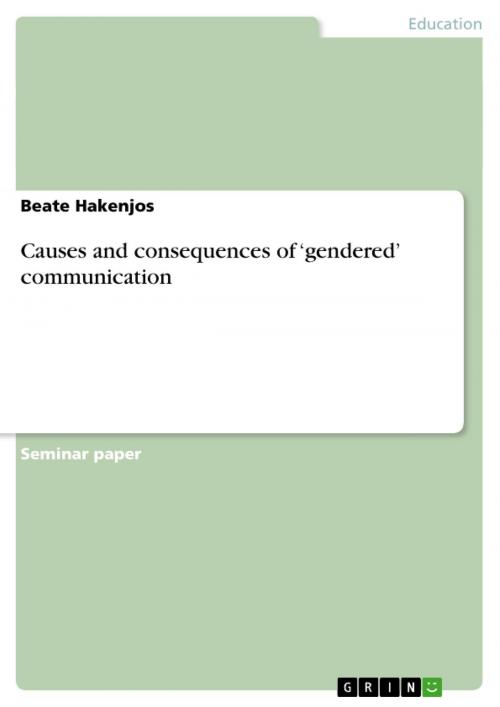Causes and consequences of 'gendered' communication
Nonfiction, Reference & Language, Study Aids, ESL, Foreign Languages| Author: | Beate Hakenjos | ISBN: | 9783640396726 |
| Publisher: | GRIN Publishing | Publication: | August 12, 2009 |
| Imprint: | GRIN Publishing | Language: | English |
| Author: | Beate Hakenjos |
| ISBN: | 9783640396726 |
| Publisher: | GRIN Publishing |
| Publication: | August 12, 2009 |
| Imprint: | GRIN Publishing |
| Language: | English |
Seminar paper from the year 2008 in the subject English - Pedagogy, Didactics, Literature Studies, grade: 1,0, Free University of Berlin (Institut für Englische Philologie), course: Linguistic Gender Studies, language: English, abstract: As Donna Haraway states, all the modern feminist meanings of gender, despite differences, have roots in Simone de Beauvoir's claim that 'one is not born a woman' (de Beauvoir, 1949; 1952, p.249) and in post-Second World War social conditions. Those conditions have enabled constructions of women as a collective historical subject-in-process. The concept of Gender was developed to question and contest the naturalization of sexual difference in multiple areas of struggle. 'Feminist theory and practice around gender seek to explain and change historical systems of sexual difference, whereby 'men' and 'women' are socially constructed and positioned in relations of hierarchy and antagonism.' (Haraway 1991). The refusal to become or to remain a 'gendered' 'woman' or 'man' is a political challenge also against the imaginary narrative of sex and race. Gender refers primarily but not exclusively to women. It defines the term 'women' as a very broad and internally differentiated category that includes differences as the highly relevant variables of class, ethnicity, religion, sexual orientation and age. Of interest are the visible and invisible power mechanisms that influence women's access to responsibility in social, economic, political, religious, intellectual and cultural life. 'Male' and 'female' are culturally produced, socially constructed categories and language is often seen as part of what constructs, maintains and reflects these categories. But on the other hand, we need categories to be able to analyse, study and describe in order to find solutions for change. Gender is transdisciplinary and a study of language, that is an essential basis for active participation in society is important. Today's gender topics are not only of importance for 'women'. In a continuously changing society they are also of concern for 'men' and require their active participation in a restructuring of society. A discussion and (re)negotiation of these issues needs participants who can and will take part equally. Over time, different approaches were developed to interpret differences in communication style between 'men' and 'women'. In the first part of this work I will try to find out: What are the causes for gender-related variation? In the second part I will look at two case studies, 'Complaint stories' by Susanne Günthner and 'TV discussions' by Helga Kotthoff, in order to answer the intertwined question: What are the consequences of gender-related variation?
Seminar paper from the year 2008 in the subject English - Pedagogy, Didactics, Literature Studies, grade: 1,0, Free University of Berlin (Institut für Englische Philologie), course: Linguistic Gender Studies, language: English, abstract: As Donna Haraway states, all the modern feminist meanings of gender, despite differences, have roots in Simone de Beauvoir's claim that 'one is not born a woman' (de Beauvoir, 1949; 1952, p.249) and in post-Second World War social conditions. Those conditions have enabled constructions of women as a collective historical subject-in-process. The concept of Gender was developed to question and contest the naturalization of sexual difference in multiple areas of struggle. 'Feminist theory and practice around gender seek to explain and change historical systems of sexual difference, whereby 'men' and 'women' are socially constructed and positioned in relations of hierarchy and antagonism.' (Haraway 1991). The refusal to become or to remain a 'gendered' 'woman' or 'man' is a political challenge also against the imaginary narrative of sex and race. Gender refers primarily but not exclusively to women. It defines the term 'women' as a very broad and internally differentiated category that includes differences as the highly relevant variables of class, ethnicity, religion, sexual orientation and age. Of interest are the visible and invisible power mechanisms that influence women's access to responsibility in social, economic, political, religious, intellectual and cultural life. 'Male' and 'female' are culturally produced, socially constructed categories and language is often seen as part of what constructs, maintains and reflects these categories. But on the other hand, we need categories to be able to analyse, study and describe in order to find solutions for change. Gender is transdisciplinary and a study of language, that is an essential basis for active participation in society is important. Today's gender topics are not only of importance for 'women'. In a continuously changing society they are also of concern for 'men' and require their active participation in a restructuring of society. A discussion and (re)negotiation of these issues needs participants who can and will take part equally. Over time, different approaches were developed to interpret differences in communication style between 'men' and 'women'. In the first part of this work I will try to find out: What are the causes for gender-related variation? In the second part I will look at two case studies, 'Complaint stories' by Susanne Günthner and 'TV discussions' by Helga Kotthoff, in order to answer the intertwined question: What are the consequences of gender-related variation?















